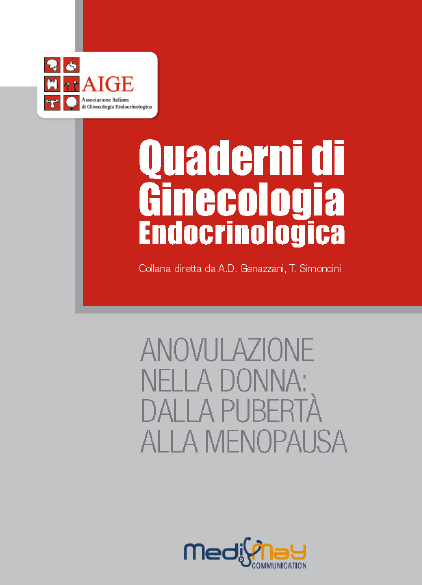-
Alessandro D. Genazzani
Expert’s opinion: integrative treatment with inositols and lipoic acid for insulin resistance of PCOSGynecological and Reproductive Endocrinology and Metabolism 2020; 1(3):146-157
Download
Abstract
PCOS is a complex syndrome that has recently been the focus of in-depth investigation. In addition to the three well known criteria established at the Rotterdam Consensus Conference, a fourth one seems to be relevant not just for the diagnosis of PCOS, but also for the choice of treatment. Hyperinsulinemia is the new issue in this syndrome and the identification of its presence can be a great help in the resolution of the many symptoms, but is mainly useful for attenuating or eliminating the risks of future impaired metabolism, dyslipidemia and cardiovascular problems.
Although metformin is a well-validated treatment for hyperinsulinism, it can induce side effects at high dosages. Over the past decade, integrative treatments using inositols and alpha lipoic acid have been proposed and reported to be greatly effective on the dysmetabolic aspects of PCOS. In addition, these integrative treatments have been demonstrated to be greatly effective especially in PCOS patients who are overweight/obese and have a familial predisposition to diabetes. This expert’s point of view will focus on these aspects.
-
Alessandro D. Genazzani, Giulia Despini, Alessia Prati, Alba Manzo, Tabatha Petrillo, Veronica Tomatis, Andrea Giannini, Tommaso Simoncini
Administration of Very Low Doses of Estradiol Modulates the LH Response to a GnRH Bolus and the LH and Cortisol Responses to Naloxone Infusion in Patients with Functional Hypothalamic Amenorrhea (FHA): A Pilot StudyEndocrines 2020, 1, 35–45
Download
Abstract
Background: Functional Hypothalamic Amenorrhea (FHA) is a stress-induced blockade of the reproductive axis. Such impairment is mainly due to altered control of GnRH-induced gonadotropin secretion as well as alterations of other endocrine functions. Methods: Seventeen patients with FHA participated in the study. Basal hormonal profiles and GnRH and Naloxone tests for LH (Luteinizing Hormone) and for LH and cortisol responses, respectively, were performed before and after two weeks of administration of a very low dose of estradiol (2.5 ng two times a day). Results: The treatment improved both gonadotropins, mainly LH. The LH response to the GnRH test improved in terms of the peak amplitude, as evaluated using Instantaneous Secretory Rates (ISR) computation. Moreover, when performing the Naloxone test after the treatment interval, FHA patients showed a quicker LH response and recovery of the cortisol response. Conclusions: Our study supports the relevance of very low dose estradiol priming to promote and restore impaired neuroendocrine function in patients with FHA
-
Andrea Giannini, Alice Antonelli, Maria M. Montt Guevara, Alessandro D. Genazzani, Massimo Stomati, Federica Pancetti, Paolo Mannella, Patrizia Monteleone, Tommaso Simoncini, Andrea R. Genazzani
DHEA restores central and peripheral BDNF levels in female castrated rats Gynecological and Reproductive Endocrinology and Metabolism 2020; 1(2):108-112
Download
Abstract
Introduction: Brain-derived neurotrophic factor (BDNF) is a neurotrophin-related polypeptide member of a family of growth factors involved in the development and preservation of the central and peripheral nervous system. Evidence has suggested that estrogen can regulate BDNF expression. The present experimental study aims to investigate possi¬ble changes in BDNF levels in selected brain areas and in plasma after the administration of different doses of DHEA in female ovariectomized (OVX) rats.
Methods: 60 healthy female Wistar rats (weight 150-200 g) were divided into six groups. Animals were treated for two weeks with estradiol valerate (E2V, 0.05 mg/kg/per day), and with different doses of DHEA (1, 2 and 5 mg/kg/per day). One group of 10 fertile and one group of 10 OVX rats were used as controls and they did not receive active treatment. BDNF was measured with an ELISA method in the frontal and parietal lobes, hypothalamus and hippocampus and in plasma samples.
Results: Gonadectomy reduced the central nervous system (CNS) and circulating levels of BDNF in fertile rats, while the administration of 0.05 mg/kg/day of E2V increased BDNF levels in all analysed areas and in plasma. The administration of DHEA 1 mg/kg/day did not affect neurotrophic tone in any of the analysed areas, while the administration of DHEA 2 mg/ kg/day markedly enhanced BDNF levels in the parietal and frontal lobes, less so in the hypothalamus and the hippocam¬pus, and showed no effect on plasma BDNF concentration. DHEA at the highest dose (5 mg/kg/day) strikingly increased BDNF levels in the hypothalamus, the hippocampus and plasma, as well as in the frontal and parietal lobes.
Conclusions: Our experimental study demonstrated that DHEA administration can protect female OVX rats from the effects of castration, restoring central and peripheral BDNF levels in a dose-dependent manner. Further investigations are necessary to understand the basis of this biological mechanism.
-
Agnieszka Podfigurna, Marzena Maciejewska-Jeske, Blazej Meczekalski, Alessandro D. Genazzani
Kisspeptin and LH pulsatility in patients with functional hypothalamic amenorrheaEndocrine 2020
Download
Abstract
Purpose Functional hypothalamic amenorrhea (FHA) occurs in response to exaggerated stressors with or without body weight loss. Various hormones, neurotransmitters, and neuromodulators are involved in the control of GnRH and kisspeptin is one of them. Our study aimed to evaluate the putative temporal coupling between kisspeptin and GnRH-induced LH pulsatile secretion.
Methods In total, 71 patients with FHA were selected for this study. All patients undergo to a pulsatility study for LH and kisspeptin evaluation (120 min, sampling every 10 min), and to an endocrine evaluation for prolactin (PRL), estradiol (E2), androstenedione (A), 17-hydroxy-progesterone (17OHP), TSH, fT3, fT4, insulin, cortisol and testosterone (T), glucose, total cholesterol, triglycerides.
Results Our data demonstrated kisspeptin and LH pulsatile secretions and that both hormones are co-secreted and temporally coupled at time 0 (p < 0.05). When patients were subdivided in hypo-LH (≤3 mIU/ml, n = 58) and normo-LH (>3 mIU/ml, n = 13), more insights were observed on the specific correlations of metabolic and hormone profiles with pulsatility indexes of LH and kisspeptin.
Conclusions Our study demonstrated the presence of a distinct kisspeptin episodic secretion in patients with FHA, and showed the temporally coupling of kisspeptin with LH secretory episodes thus supporting that though in amenorrhea, the reproductive axis is still relying on kisspeptin to drive GnRH discharge. In addition, correlations among hormonal data sustain the hypothesis that stress-induced compensatory events are the main direct and indirect promoters of the reproductive blockade in patients affected by FHA.
-
Angela Baerwald, Roger Pierson
Ovarian follicular waves during the menstrual cycle: physiologic insights into novel approaches for ovarian stimulationFertil Steril 114: 443-457, 2020
Abstract
Elucidation of multiple waves of antral ovarian follicular development during the menstrual cycle has challenged traditional concepts of female reproductive physiology and foundations of assisted reproductive therapies. Approximately two-thirds of women develop two follicle waves throughout an interovulatory interval and the remainder exhibit three waves of follicle development. Major and minor waves of follicle development have been observed. Major waves are those in which a dominant follicle develops; dominant follicles either regress or ovulate. In minor waves, physiologic selection of a dominant follicle is not manifest. Knowledge of waves of antral follicular development has led to the global adoption of novel ovarian stimulation strategies in which stimulation can be initiated at various times throughout the cycle. Random-start and luteal-phase ovarian stimulation regimens have had important clinical applications for women requiring urgent oocyte or embryo cryopreservation for fertility preservation prior to chemotherapy. Ovarian stimulation twice in the same cycle, referred to as double stimulation, may be used to optimize clinical outcomes in women with a poor ovarian response to stimulation as well as in those requiring fertility preservation before chemotherapy.
-
Suvi T. Ruohonen, Matti Poutanen, Manuel Tena-Sempere
Role of kisspeptins in the control of the hypothalamic-pituitary-ovarian axis: old dogmas and new challengesFertil Steril 2020;114:465–74
Download
Abstract
In humans and other mammals, a hallmark of female reproductive function is the capacity to episodically release fertilizable oocytes under the precise control of a cascade of hormonal regulators that interplay in a cyclic manner within the hypothalamic-pituitaryovarian (HPO) axis. Although the basic elements of this neurohormonal system were disclosed several decades before, a major breakthrough in our understanding of how the HPO axis is controlled during the lifespan came in the first decade of the 21st century, when the reproductive dimension of kisspeptins was disclosed by seminal studies documenting that genetic inactivation of the kisspeptin pathway is linked to central hypogonadism and infertility. Kisspeptins are a family of peptides, encoded by the Kiss1 gene, that operate via the surface receptor, Gpr54 (also called Kiss1r), to regulate virtually all aspects of reproduction in both sexes. The primary site of action of kisspeptins is the hypothalamus, where Kiss1 neurons engage in the precise control of the pulsatile release of GnRH to modulate gonadotropin secretion and, thereby, ovarian function. Nonetheless, additional sites of action of kisspeptins within the HPO axis, including the pituitary and the ovary, have been proposed; yet, the physiologic relevance of such extrahypothalamic actions of kisspeptins is still a matter of debate. In this review, we summarize the current consensus knowledge and open questions on the sites of action, physiologic roles, and eventual therapeutic implications of kisspeptins in the control of the female reproductive axis.
-
Paolo Giovanni Artini, Maria Elena Rosa Obino, Elisabetta Micelli, Elisa Malacarne, Chiara Vacca, Francesca Papini & Vito Cela
Effect of d-chiro-inositol and alpha-lipoic acid combination on COH outcomes in overweight/ obese PCOS womenGynecological Endocrinology, 36:9, 755-759, 2020
Abstract
Insulin resistance (IR) plays a central role in the onset of polycystic ovary syndrome (PCOS). Insulin so insulin-sensitizing like inositols have been proposed as first line therapy. Among them D-chiro-inositol (DCI) seems to improve glucose metabolism and to increase ovulation frequency. Other studies have demonstrated that alpha-lipoic acid (ALA), with its antioxidant role, can also improve endocrine and metabolic profile of PCOS patients especially with familial diabetes. This a retrospective observational study with the aim to evaluate possible advantages of an integrative preparation combining DCI 500 mg and ALA 300 mg in overweight/obese PCOS patients with or without diabetic relatives who underwent IVF. Twenty PCOS patients who were taking the integrative preparation underwent controlled ovarian hyperstimulation in our center. The group with diabetic relatives tended to have a lower dose of gonadotropin, shorter stimulation days, higher number of MII oocytes, and higher number of fertilized oocytes. A combined regimen of DCI and ALA could be an interesting strategy in overweight PCOS patients with familial diabetes underwent ART.
-
Büşra Başar Gökcen, Yasemin Akdevelioğlu, Sultan Canan & Nuray Bozkurt
Increased risk of eating disorders in women with polycystic ovary syndrome: a case-control studyGynecological Endocrinology, 36:9, 764-767, 2020
Abstract
Data on eating disorders in women with PCOS is insufficient. The objective of this case study was to examine the hypothesis that women with PCOS exhibit more impaired eating than healthy women. Women diagnosed with PCOS under the 2003 Rotterdam Diagnostic Criteria (n = 40) were compared with a healthy control group (n = 40). The groups also were divided into two as normal body weight and overweight/obese. The Eating Disorders Assessment Questionnaire (EDE-Q) and the Three Factor Eating Questionnaire (TFEQ-R21), were completed by all participants in order to evaluate eating behaviors in addition to eating disorders. Among the overweight/obese group, the average total and subscale scores of the EDE-Q as well as the total and sub-factor scores of the TFEQ-R21 were higher in women with PCOS compared to controls (p < .05). However, this statistically significant result was not shown among the women with normal weight (p > .05). In comparison to the controls, the PCOS women displayed higher values of the tool scores indicating abnormal restraint eating, body shape concern and weight concern subscale scores (p <.05). This result suggests that the evaluation of eating disorders should be added to routine screening and the monitoring of women with PCOS.
-
Maryam Kazemi, Brittany Y. Jarrett, Stephen A. Parry, Anna E. Thalacker-Mercer, Kathleen M. Hoeger, Steven D. Spandorfer, Marla E. Lujan
Osteosarcopenia in Reproductive-Aged Women with Polycystic Ovary Syndrome: A Multicenter Case-Control StudyJ Clin Endocrinol Metab, September 2020, 105(9):e3400–e3414
Download
Abstract
Context: Osteosarcopenia (loss of skeletal muscle and bone mass and/or function usually associated with aging) shares pathophysiological mechanisms with polycystic ovary syndrome (PCOS). However, the relationship between osteosarcopenia and PCOS remains unclear.
Objective: We evaluated skeletal muscle index% (SMI% = [appendicular muscle mass/weight (kg)] × 100) and bone mineral density (BMD) in PCOS (hyperandrogenism + oligoamenorrhea), and contrasted these musculoskeletal markers against 3 reproductive phenotypes (i): HA (hyperandrogenism + eumenorrhea) (ii); OA (normoandrogenic + oligoamenorrhea) and (iii), controls (normoandrogenic + eumenorrhea). Endocrine predictors of SMI% and BMD were evaluated across the groups.
Design, Setting, and Participants: Multicenter case-control study of 203 women (18-48 years old) in New York State.
Results: PCOS group exhibited reduced SMI% (mean [95% confidence interval (CI)]; 26.2% [25.1,27.3] vs 28.8% [27.7,29.8]), lower-extremity SMI% (57.6% [56.7,60.0] vs 62.5% [60.3,64.6]), and BMD (1.11 [1.08,1.14] vs 1.17 [1.14,1.20] g/cm2) compared to controls. PCOS group also had decreased upper (0.72 [0.70,0.74] vs 0.77 [0.75,0.79] g/cm2) and lower (1.13 [1.10,1.16] vs 1.19 [1.16,1.22] g/cm2) limb BMD compared to HA. Matsuda index was lower in PCOS vs controls and positively associated with SMI% in all groups (all Ps ≤ 0.05). Only controls showed associations between insulin-like growth factor (IGF) 1 and upper (r = 0.84) and lower (r = 0.72) limb BMD (all Ps < 0.01). Unlike in PCOS, IGF-binding protein 2 was associated with SMI% in controls (r = 0.45) and HA (r = 0.67), and with upper limb BMD (r = 0.98) in HA (all Ps < 0.05).
Conclusions: Women with PCOS exhibit early signs of osteosarcopenia when compared to controls likely attributed to disrupted insulin function. Understanding the degree of musculoskeletal deterioration in PCOS is critical for implementing targeted interventions that prevent and delay osteosarcopenia in this clinical population.






